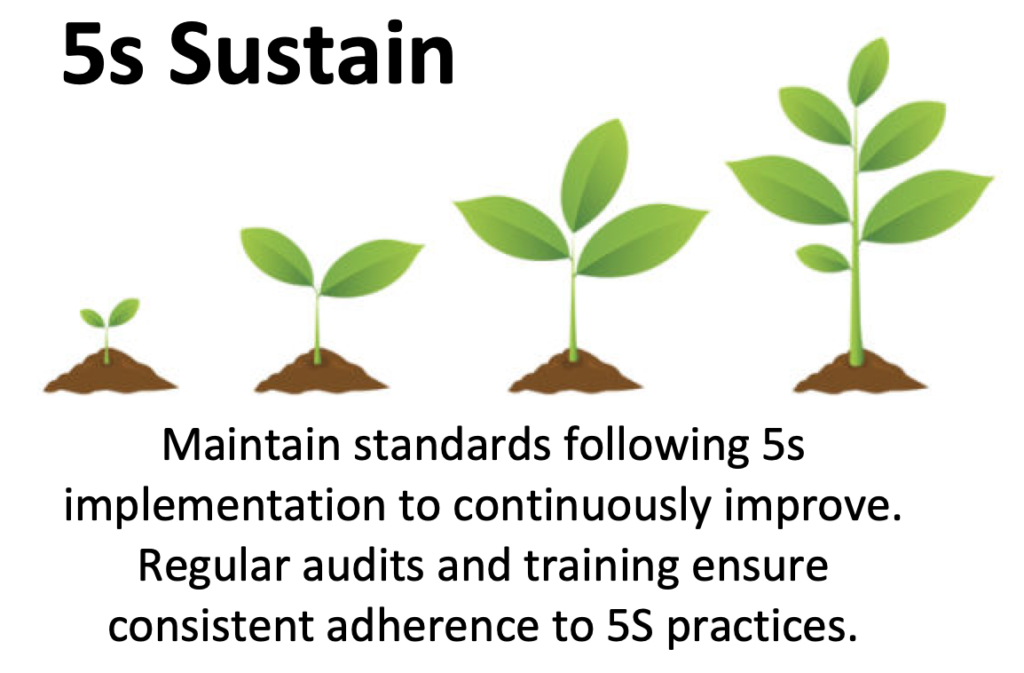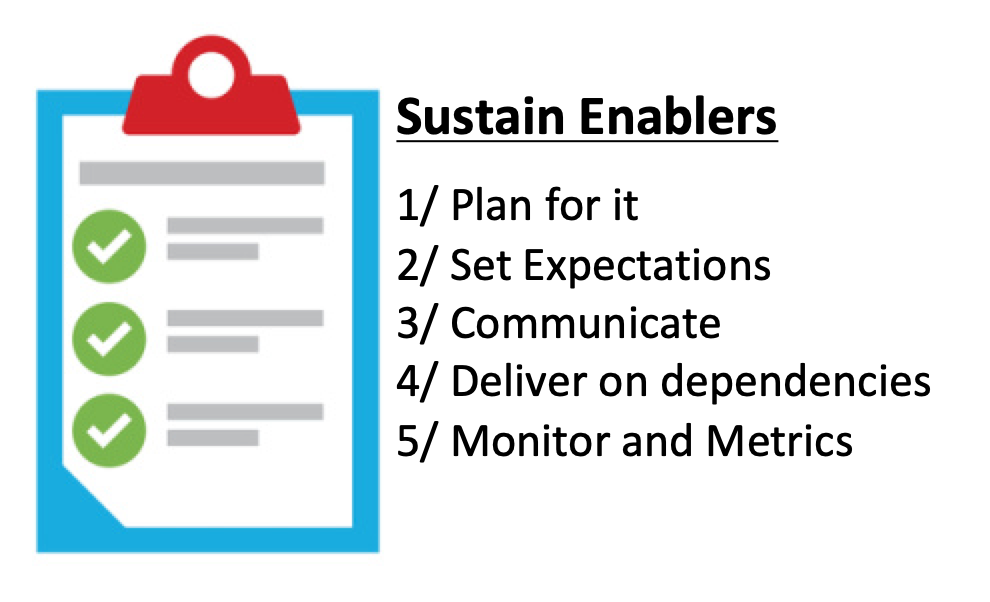Many companies use 5S to improve efficiency within their workplace. Its principles, focusing on establishing a clean and well-organized work environment, can bring about improvements in several areas, from safety to quality and productivity. However, many organizations struggle to sustain the changes implemented and, as a result, fail to obtain planned benefits.
As a result of the challenges around sustaining change, how to sustain 5s must be a key goal in any 5s rollout. In order to achieve this, we can utilize a variety of strategies.
At the heart of these is establishing a culture of continuous improvement within the organization. This can commonly involve ongoing training and communication with employees, regular audits and inspections to ensure adherence to 5S principles and a commitment to improvements bought about by change.
In today’s article, we’ll be discussing further how to sustain 5s; we’ll be looking at:
- What is 5s
- What does sustain mean in 5S?
- How to recognize that 5s is not being sustained
- What happens if you don’t sustain 5s
- Motivating people to sustain 5S?
- Understanding the disadvantages of 5s
What is 5s
Let’s first briefly look at the 5s methodology.
5S targets efficiency improvements through improving processes and workspace layout through standards and cleanliness. The result of which, when deployed correctly, includes productivity benefits, reducing waste and delivering optimization.
5S is often used in manufacturing and industrial settings, but it can be applied to any workplace that values organization and efficiency.
It is based on five key principles:
- Sort – Identifying and removing unnecessary items from the work area
- Set in order – Standardizing work area by arranging items in a logical and efficient manner
- Shine – Ensuring a work area is clean
- Standardize – developing policies and procedures for tasks.
- Sustain – maintaining the gains achieved through the previous four principles and continuously improving processes over time.
What does sustain mean in 5S?
The key to 5s is that we are bringing about a change and then sustaining that change.
As a methodology, despite its relative simplicity and benefits, there are still several challenges to consider when implementing 5s;
- Complacency – incorrectly thinking that change does not require effort.
- Resistance to change
- Lack of leadership support
- Failure to sustain change
Let’s take a look at that last one. Sustainment is a critical aspect of 5s; indeed, as we described, the fifth S is “Sustain”.
But what do we mean by sustain?
In the context of 5s, sustain refers to maintaining changes implemented within the area where it has been deployed.
We can sustain 5s by ensuring changes that have been made during the initial deployment, including policies and processes, are adhered to and that the organization continues to improve through continuous improvement activities.
In order to do this effectively, we require a series of enablers which include:
- Establishing expectations of the 5S implementation and communicating these to the workforce, ensuring that the importance of the change program is well understood.
- Obtaining buy-in from the organization or functional area that you’re deploying 5s into.
- Ensuring appropriate enablers are considered when deploying change, this may include aspects such as:
- Training
- Processes and policies
- Tools and Systems
- Dependencies
- Barriers
- Monitoring results and benefits, has the change resulted in what was expected? This will also need to be communicated to the workforce.
- Ensuring sustainment is a recognized part of the delivery plan and that this is supported and monitored

How to recognize that 5s is not being sustained
But how do we recognize if sustainment is not successful or if it’s happening at all?
There are likely to be several signs to look out for, including:
- A clear lack of engagement and participation from employees.
- Visible signs – A simple example might be tools and/or materials cluttering up workspaces following the 5s deployment.
- No accountability for ensuring 5s is being followed
- Lack of follow-up. For example, no established metrics or performance measures to monitor the sustainment of progress
- Some follow-up but worsening metrics.
By recognizing signs of a lack of sustainment, organizations can re-engage with employees and deploy recovery actions resulting in a higher likelihood of success.
What happens if you don’t sustain 5s
So let’s look at the “so what”, what happens if you don’t sustain 5s
5s is carried out for a purpose; to drive effectiveness and efficiency.
If an organization uses 5s but then fails to sustain it, There could be a range of consequences which are collectively likely to mean that effectiveness and efficiency targets are unlikely to be met.
The reason for this is that without the sustained effort to maintain changes, 5s’d areas can quickly fall back into disarray and back to historical performance levels achieved before the 5s deployment.
It’s imperative to consider 5S as a continuous event, a process that is continuous and therefore requires commitment in order to deliver on its promise.

Motivating people to sustain 5S?
The key behind sustaining 5s is people.
Motivating people to embrace change (and practice 5S principles) is a the heart of any successful 5s implementation.
There are several strategies that can be used to ensure buy-in; these include:
- Communication: Explain the benefits of 5S and ensure a shared understanding of its importance
- Deliver dependencies – the organization must deliver on dependencies to help employees capitalize on changes (this might be as simple as training but could be more complex)
- Make 5s a whole organization activity – 5s should be a tool used throughout the business at all levels, not just something that is “done” to a particular area, such as an assembly line. A key element of this is the encouragement of cross-functional teams at all levels to work together to implement and sustain 5S.
- Recognize and reward success.
- Make continuous improvement part of the organizaiton’s framework.

Understanding the disadvantages of 5s
As with any improvement initiative, there are potential disadvantages to consider. These disadvantages can affect how change happens and how that affects sustainment. These should be considered in the planning phase in order that they can be mitigated – some of the disadvantages include:
- Time-consuming: The 5S methodology can be time-consuming, particularly in the early stages when significant effort may be required to implement changes and establish new ways of working. This can impact productivity and create short-term disruptions.
- Cost: Implementing 5S is not free – it requires people’s time and may require investment in new equipment, tools, and materials, as well as training and education.
- Resistance to change: Some employees may be resistant to changes in established work practices, leading to a lack of engagement.
- Overemphasis on cleanliness: 5s is not just about being clean. An overemphasis on cleanliness can lead to a focus on superficial appearances rather than substantive improvements to workplace organization and efficiency.
- Limited applicability: The 5S methodology may not be appropriate for all workplace environments and industries, particularly those with highly specialized processes or equipment. Trying to use any methodology that is not fit for purpose within the area your deploying it is asking for trouble.
Summary
Sustaining the 5S methodology requires ongoing effort, commitment, and support from all levels within an organization.
To avoid potential challenges, it’s essential to plan ahead, communicate the benefits of 5S to employees, provide adequate training and resources, and prioritize sustainability through regular monitoring and review.
Have you deployed 5s in your organization? How did you tackle sustaining your changes? As ever, we’d love to hear from you – you can reach us in the comments section below or via Twitter.
